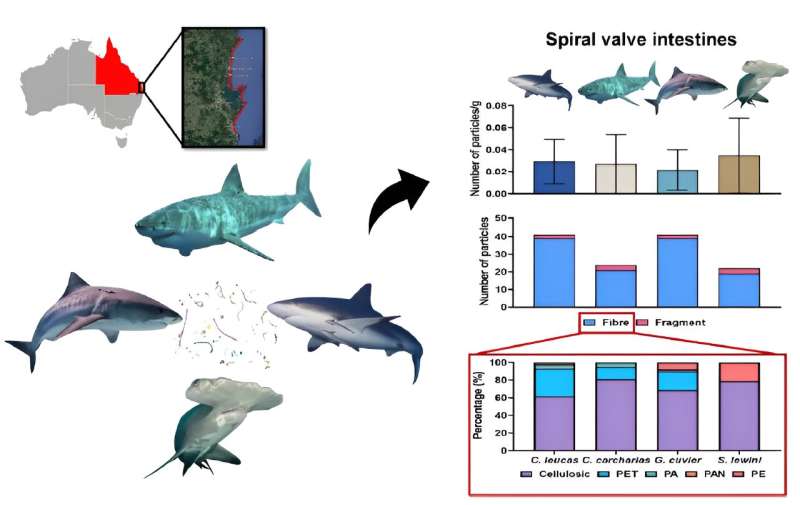This article has been reviewed according to Science X's editorial process and policies. Editors have highlighted the following attributes while ensuring the content's credibility:
fact-checked
trusted source
proofread
Microplastics present in muscles, intestines of South East Queensland sharks

Researchers have discovered not only microplastics but also a higher abundance of cellulose-based fibers in the intestine samples of four apex shark species caught off the coast of South East Queensland (SEQ).
The finding sheds light on the potential food-chain transfer or direct ingestion of foreign materials by these marine predators.
The study, led by Ph.D. candidates Hsuan-Cheng Lu and Julia Smith from Griffith University's ARI-TOX research group in the Australian Rivers Institute, marks the first investigation of microplastics and other anthropogenic fibers in both intestine and muscle samples of large apex shark species in Australian coastal waters.
The study, "Microplastics and other anthropogenic fibers in large apex shark species: Abundance, characteristics, and recommendations for future research," has been published in Chemosphere.
Microplastics and anthropogenic fibers were found in 82% of the analyzed intestine samples from sharks including tiger sharks, white sharks, bull sharks and scalloped hammerheads with a mean abundance of 31 ± 21 particles/kg of samples.
While the abundance was less than what has been found in fish, the findings indicated that anthropogenic fibers, including both synthetic and non-synthetic fibers, were finding their way into all corners of our environment.
The majority (70%) of these fibers were identified as cellulose-based, followed by polyethylene terephthalate (PET) fibers.
These fibers are common material used in textiles, such as clothing and carpets, and can be released through washing and drying.
Recently, personal care products, such as face masks and wet wipes, were reported as additional potential sources of these microfibers.
The research also revealed that 60% of shark muscle samples contained microplastics and anthropogenic fibers, with cellulose-based fibers being predominant.
Lu emphasized the importance of addressing methodological differences to enable a more comprehensive assessment of microplastic contamination in future studies.
"While microplastics have been widely reported in the marine environment and marine organisms at different trophic levels, our knowledge about the exposure and ingestion of microplastics by marine megafauna, such as whales and sharks, is still limited," Lu said.
"The presence of microplastics in the four large apex shark species further highlights how widespread these small but harmful plastic particles have now spread in our environment and how difficult it will be to address global microplastic pollution.
"The higher abundance of cellulosed-based fibers was unexpected, given the dominance of synthetic fibers in current global production.
"Some studies have reported that textiles made of cellulose-based material shed and release more fibers than their synthetic counterparts during laundering."
Despite being derived from natural materials (e.g., cotton) or regenerated from cellulose (e.g., rayon and viscose), cellulose-based fibers often contained a suite of chemical additives, dyes, and finishing agents added during production, which are likely to be released because non-plastic fibers degraded much quicker than their plastic equivalents.
The team also identified challenges encountered during sample processing and provided recommendations to enhance experimental design and analytical methodology for future investigations in this field.
"The presence of microplastics and cellulose-based fibers not only in the intestines but also in muscle tissues underscores the urgent need for further research on the potential risk to marine organisms and proactive measures to mitigate the impact of anthropogenic pollution on marine ecosystems, particularly on megafauna such as apex sharks," Lu said.
More information: Hsuan-Cheng Lu et al, Microplastics and other anthropogenic fibres in large apex shark species: Abundance, characteristics, and recommendations for future research, Chemosphere (2023). DOI: 10.1016/j.chemosphere.2023.140957
Provided by Griffith University


















